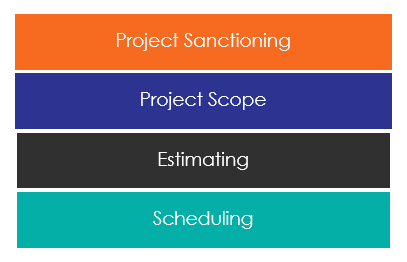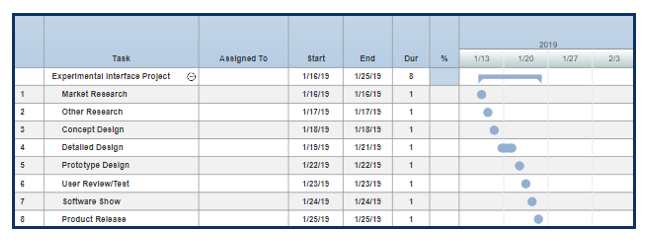Welcome to
Project Management broken downStarting your project out right
Module Three
Develop a Project Plan
In this module, you’ll create an actual project plan that will help you frame your project. This process will help you create guidelines and protocols, so that you can repeat the project in the future and carry it out more effectively and efficiently. You can save your plan and use it for other types of projects in the future too.
Proper planning is the key to effective management. If you invest the time in planning well upfront, this is one of the best ways to ensure that the project goes smoothly and successfully achieves its aims.
One of the biggest mistakes businesses make here is to assume that because a project is small, it doesn’t require the same thorough planning as a large endeavor. A person may jump right into the work without planning. However, lack of planning can have the same problems for small projects as it does for medium and large projects.
The planning stage takes the most investment and effort, but if it’s done well, the rest of the project simply involves execution and reporting. The effort expended here means less effort and less decision-making later.
There are four key components to project planning:
Project sanctioning, project scope, estimating, and scheduling.

Project Sanctioning
Sanctioning involves getting the approval of the project sponsor before the project officially starts. First, you need to identify who the project sponsors are.
A project sponsor is the party that is, in simple terms, asking for the project to be carried out. The sponsor can be either internal or external stakeholders. If you are working with clients, the client is the project sponsor. When this is the case, the client is the number one authority on everything that goes on. The client determines whether or not the project is a success. In this situation, the client is referred to as “top level support.” Top level support is the person who is authorized to sign off or make purchases.
The project charter is a document that outlines what the sponsor or client expects the project to produce.
This is a statement of the scope, objectives, and participants in a project. It’s an overview that allows everyone involved in the project to easily understand its purpose and objectives. The charter is intended to be a business document, not a technical document, so it should be a short summary without every little detail.
Project sanctioning occurs when the sponsor signs off on the charter.
There may be other external sponsors as well. Internal sponsors include supervisors or other departments within your company. In some cases, you may be running a project for yourself. Examples of this would be things like setting up your own website, opening an ecommerce store, or carrying out a marketing campaign. In this case, you don’t need t0o sign off, but you still need a project charter that outlines the project and its requirements.
Be cautious of project handoff. If the person you’re working with directly during the project is different than the signing authority, make sure the individual who signed your charter is your point of contact. It’s called “project handoff” when one person signs off on a project and then another becomes a point of contact. This can cause major miscommunication and confusion.
Example 1:
Let’s imagine that you are a salon owner working with a bridal party to plan hair and make-up for a wedding. If the bride is paying but the bridesmaid calls to make changes to the specs, always verify the changes with the bride herself. She is the official sponsor and signing authority.
Example 2:
You’re an instructional designer developing an online module for a company. You work with the executive director of the client company for budgeting and scoping, but the executive director then introduces you to a subject matter expert who then becomes your main point of contact. Remember that it’s the executive director, not the subject matter expert, who needs to sign off on the charter.
It’s okay if your point of contact is another person other than the signer for the purposes of regular communication during the project. But be careful whenever changes are asked for or when approval is needed.
Example 3:
Let’s say that you’re managing social media profiles for a dentist who is the signer, but your point of contact is the dentist’s office manager. If the office manager asks you to set up an additional profile, you need to verify with the dentist first.
In other cases, you may be asked to work with a team from your client company. For example, you’re a virtual assistant planning a retreat for your boss’s key clients. You may be asked to work on the details with his other team members, but the boss himself or herself must sign off on the charter, which outlines the main goals and deliverables.
Project Charter
As part of sanctioning, you also need to draft the project charter we just mentioned, before getting started. The project charter includes the details of the project, such as its objectives, sub-phases, tasks, resources, and so on. It also includes the next two components, estimating and scheduling. Along with the objectives, the charter should define all business issues or impact that the project is addressing.
At the top of your project charter, list the essential people associated with the project. These include:
- Project Name
- Project Sponsor
- Project Manager (the person in charge of the project)
- A list of all members of the project team
There should then be a project description, which summarizes the major points of the project including its purpose.
One of the most important parts of the charter is the project scope. This defines exactly what the project entails and what it doesn’t. What it doesn’t entail is “out of scope,” meaning that these things are not handled by the project manager and team, but by someone else; in other words, the project sponsor needs to use their own resources to get these things done.
The scope should include things like:
- Business issues to be addressed by the project
- Business impact to be addressed by the project (expected results)
- Project objectives
- Main project deliverables
- In scope
- Out of scope
You may also include examples of optional items that would be “add-ons” which are out of scope but can be arranged.
This charter document should include the final due date for all deliverables and a place where the project sponsor will sign off on the project after reading this document.
Estimating
Your project plan charter should also include a specific breakdown of the smaller tasks that make up the project and a schedule for starting and finishing each.
During the planning phase, you need to figure out how much investment of time and other resources each part of the project is going to take. In order to do this, you need to break it down into its constituent tasks and consider each task separately. This is called Work Breakdown Structure (WBS).
Example:
You’re a graphic designer and the deliverable for your project is a logo for a company. There are a number of tasks that include: getting your client to fill in a form about their company; first drafts of three logo options which must be sent to the client and approved; a first draft of the logo idea chosen by the company based on the client’s feedback; a final revision of the logo again using client feedback; and packaging the final digital files for the client.
Using WBS, you would estimate the time each of these tasks would take. You can then estimate how long the overall project will take.
Scheduling
Finally, schedule your tasks by putting all of them in a logical order and on a fixed timeline. This will create a workflow that ensures the work will get done in the right order by the deadline. As you sequence the individual tasks you identified, the total amount of time added together will determine the project length.
Keep in mind that you’ll have your regular work and responsibilities as well. You may also be managing multiple projects at one time. Pad your estimates at first and don’t over-promise on when you can have the work done. As you carry out more projects similar to this one, you’ll naturally develop a better handle on juggling new projects with regular work.
Use your calendar to schedule the parts of your project. If you’re using multiple calendars combine them into one and make it collaborative so that the others involved can see it. Book all of your activities, including calls, appointments, independent work, meetings, and research. If they’re all in one place where you can take in your tasks at a glance, this will make fitting in your project much easier.
There should be a section of your project charter where the above tasks are listed. Take each major milestone and list all of the tasks that need to be accomplished. Clearly identify who will be responsible for carrying out each task, a date for when it will be started, and a date for when it will be finished. Please refer to the “Project Plan and Charter Template” to see an example of what this document would look like.
Project Planning Tools
There are a number of useful tools you can use in project planning. The tools mentioned here are just a sampling of what’s available. These are tools that have a generally good reputation among project managers.
One tool you can use is a Gantt chart. A Gantt chart is a bar chart that provides a graphical illustration of a schedule. It helps you to plan, coordinate, and track specific tasks in a project. You can see an example of a Gantt chart here. And here’s another example of one created using Smart Draw:

Asana is a web-based software-as-a-service designed for project team collaboration. It creates a virtual workspace that allows team members to work together without the use of email or any other outside communication. You create a workspace and then add projects to it. Each project can have tasks added to it. In each task, users can add notes, comments, attachments, and tags. Team members can set up updates so that whenever a change is made, they’ll be notified by email.
Basecamp is a web-based project management tool that includes a wide range of features such as to-do lists, wiki-style web-based text documents, milestone management, file sharing, time tracking, and a messaging system. It’s very comprehensive. Basecamp is free for your first project and then $29 per month.
Trello is a web-based project management application that uses visual representation to make project management easier. It gives you “cards” for each task. Trello works on a freemium business model where the basic service is free but there’s a premium full service version as well.
Google offers a free way to create and collaborate on files in Google Drive – Docs, Sheets, Slides, Forms, Photos, and more. You can see when someone else is working on a file, and you can upload and download file formats from programs like Microsoft Office. Storage is free for up to 15 GB in Drive, but can then pay to upgrade to a larger amount of storage.
We’ve included a list of other possible project management tools in a separate handout since there is an endless array of choices.
Tips on Choosing and Using Tools
Whatever tool you choose, make sure it’s something you’re comfortable with. If it’s a premium service, take advantage of a free trial to see if it’s easy for you to use. Simple tools are the best. Many people use Excel or Word simply because they’re already familiar with them.
One option if you’re already using tools such as these is to use a cloud service like Dropbox, OneDrive, or Google Drive. Once in the cloud, every member of the project can access them, make real-time updates, and enable notifications. By not having to learn a new tool, you can save time.
Activity:
- Choose a project management tool.
Then, using the project you identified and the provided Project Plan and Charter Template, create a project plan that incorporates as many of the elements discussed in this module as possible.
Get input from team members or your project sponsor to fill in any blanks.
A Word
From Tamara
As an entrepreneur myself I completely understand the stress, anxiety and frustration around launching or growing a business. I also know the rewards and life style change the hard work can provide you if you stay focused. I am here to inspire and motivate you to push forward. The fact that you’re investing in your business education let’s me know you’re in this to win. Rest assured I’m here to help you…. These courses are set up to help you understand the basics. To dig deeper into your specific plan of action we will discuss where you are, where you want to be, eliminate any blocks preventing you from getting to the next step and create an action plan.

Our superpower is making you a superhero.

